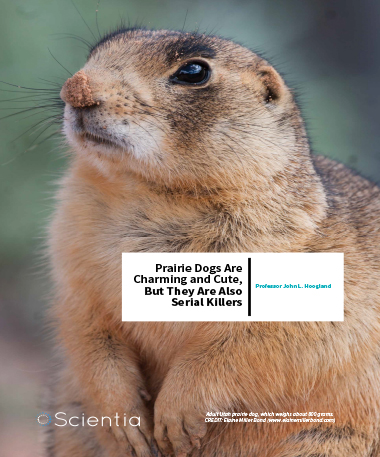Professor John L. Hoogland – Prairie Dogs Are Charming And Cute, But They Are Also Serial Killers
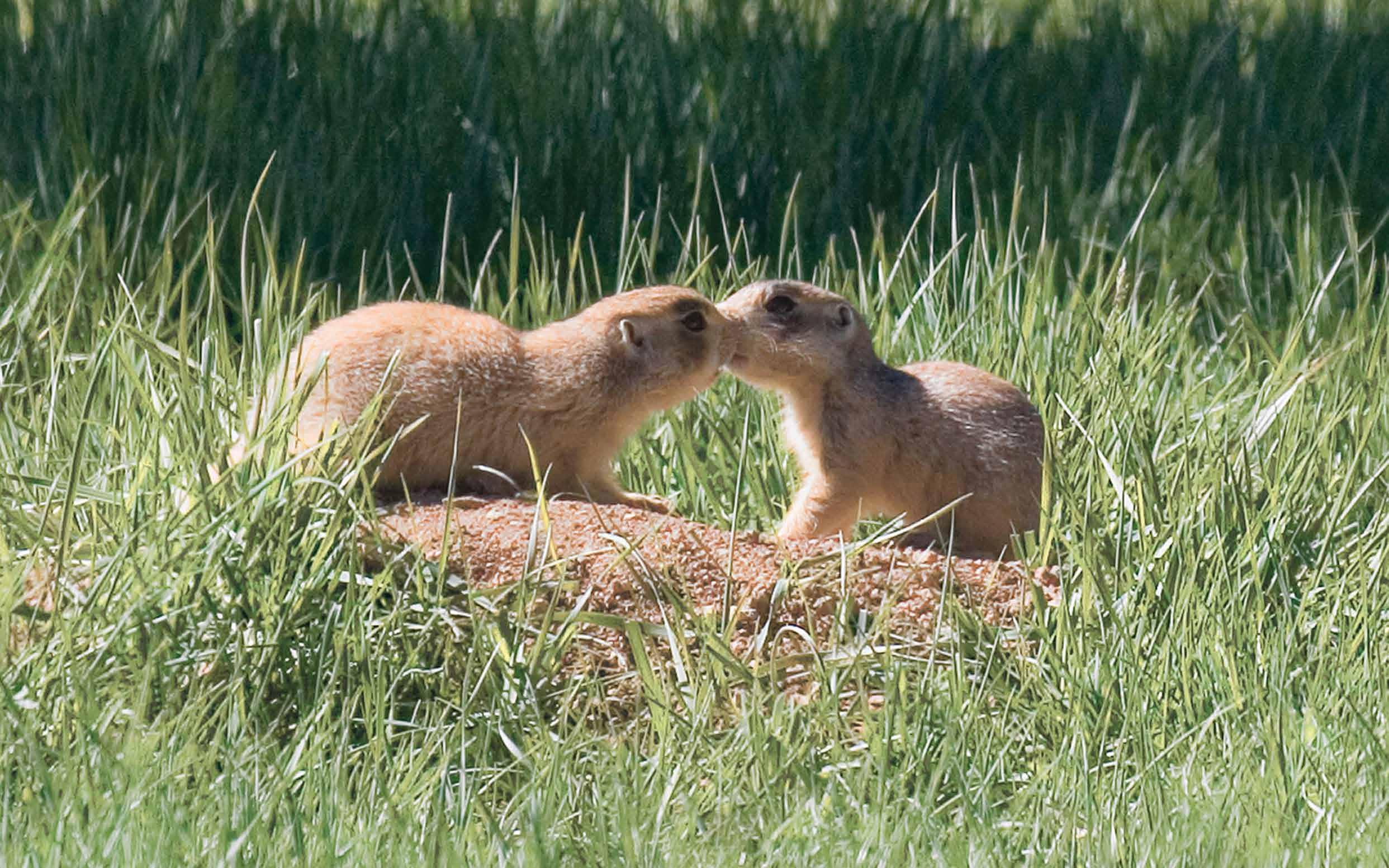
Behavioural ecologist Professor John Hoogland’s research career began with a deceptively simple question: Why do animals live in colonies? To pursue the answer, he turned to prairie dogs, which are diurnal, herbivorous, squirrel-like rodents that live in large colonies throughout the grasslands of western North America. These gregarious rodents, whom John frequently calls his ‘little people’, have afforded him unique opportunities for his research over the last four decades, with sweeping conclusions for not only prairie dogs, but also other social animals.
Life in the Colony
In April 1974, while working on a PhD at the University of Michigan, John found himself in a devastating situation for a young graduate student. While attempting to study colony dynamics of Wyoming ground squirrels, he discovered that, contrary to popular belief at the time, Wyoming ground squirrels do not actually live in discrete colonies. One night John broke down and sobbed to his new bride (Judy) about his calamity. Judy instantly responded, ‘Why not study prairie dogs? Everybody knows that prairie dogs live in colonies.’ John listened, and visited a colony of prairie dogs the next day. Within a few minutes of his arrival, John was mesmerised by the nonstop vocalisations, and by the chases, fights, and kisses that he was seeing everywhere.
John quickly developed the simple protocol of ‘Catch ’em. Mark ’em. Watch ’em.’ He and his students – usually 4–5 per year, with a grand total over 200 – took this protocol to a new level over the next 44 years: an inconceivable >200,000 man-hours of research with four different species of prairie dogs under natural conditions at national parks in Arizona, Colorado, New Mexico, South Dakota, and Utah. And yet John still says at every one of his lectures, ‘The more I learn about prairie dogs, the less I know.’
John’s initial research focused on trying to figure out why prairie dogs live in colonies. When compared with solitary prairie dogs, colony residents face higher competition for food, mates, and other resources, and they also incur a higher risk for contracting nasty diseases and parasites.
But what are the compensating advantages that over-ride these serious costs? John’s early research showed that the major benefit to living in a colony for prairie dogs is the lower risk of being captured by a predator. ‘With so many individuals within a colony watching for enemies, the probability that a bobcat, coyote, or golden eagle will be able to capture a prairie dog is low,’ John says.
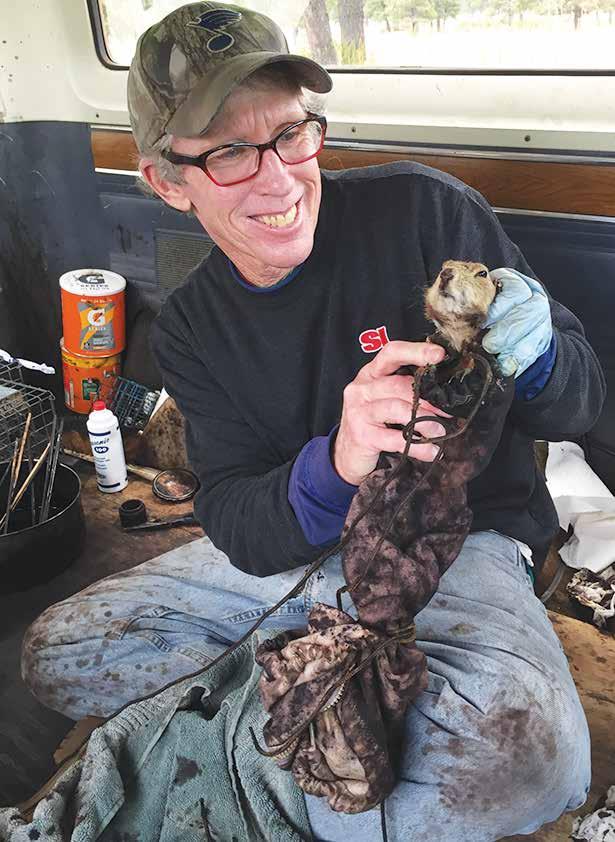 The alarm call in response to predators is a pivotal reason for this increased safety. But alarm calling is puzzling. Why should an individual draw a predator’s attention to itself by calling in order to save other prairie dogs with whom it competes? The payoff is that alarm calls warn genetic relatives of danger. These calls warn nearby offspring for three of the prairie dog species that John has studied. For the fourth species, individuals call not only for offspring, but also for more distant kin such as nieces, nephews, and cousins.
The alarm call in response to predators is a pivotal reason for this increased safety. But alarm calling is puzzling. Why should an individual draw a predator’s attention to itself by calling in order to save other prairie dogs with whom it competes? The payoff is that alarm calls warn genetic relatives of danger. These calls warn nearby offspring for three of the prairie dog species that John has studied. For the fourth species, individuals call not only for offspring, but also for more distant kin such as nieces, nephews, and cousins.
Predation of prairie dogs is rare, as just noted. When it occurs, John was expecting that the old, the weak, and the sickly would be the most common victims. But the prairie dogs surprised him. He learned that the largest, most aggressive, and most successful males in one species are the most susceptible to predation during the mating season – because they are so obsessed with finding and inseminating receptive females, with little fear of predators. And for the 3rd and 4th weeks after they mate, females in late pregnancy are especially vulnerable – because they are overweight with as many as 8 large foetuses, and therefore unable to run as fast as other prairie dogs.
John Hoogland reading the eartags of one of his Gunnison’s prairie dogs; note the canvas bag used for handling.
‘Long term research and careful analyses are crucial and decisive for understanding the ecology and social behaviour of animals as complex as prairie dogs. I have been fortunate to spend a lifetime studying these captivating keystone species. Consequently, I have been able to make several riveting discoveries that have led to novel, far-reaching conclusions.’

CREDIT: Elaine Miller Bond (www.elainemillerbond.com) Utah prairie dog male attacking another male during the mating season
Family Matters
Family dynamics can be complicated when your entire extended family lives in a small area, as occurs for all four species of prairie dogs that John has studied. One of his early objectives after graduate school was to figure out if prairie dogs are concerned about incest. The solution did not come easily, because the mating season lasts for only 3 weeks in late winter and early spring at high altitudes, where temperatures are low and arctic winds are relentless. Further, each female is sexually receptive for only several hours on a single day. And finally, most copulations occur underground! By watching marked individuals from dawn to dusk every day, by watching for diagnostic aboveground behaviours just before and just after an underground copulation, and by collecting DNA-samples from all juveniles and all potential parents, John and his students are able to specify who mates with whom for over 95% of females at their study-colony each year. By following parents and their offspring – for a minimum of 10 years for each of four species – John has documented that prairie dogs consistently avoid incestuous matings with close kin such as parents, offspring, and siblings, even though these genetic relatives frequently live in the same or adjacent territories. Such avoidance reduces the problem of inbreeding depression (the reduction of survivorship of inbred offspring). But prairie dogs frequently mate with more distant kin such as aunts and uncles, nieces and nephews, and first and second cousins. So they avoid extreme inbreeding (incest), but prairie dogs regularly engage in moderate inbreeding.
John’s careful observations of the prairie dog mating system have provided insights for another conundrum first recognised by Charles Darwin almost 150 years ago: polyandry (i.e. mating with more than one male). ‘Females of almost every sexual species that has been carefully studied – from plants and slime moulds through humans and other primates – commonly solicit sperm from two or more males,’ he explains. ‘But this is a paradox, because a female can almost always obtain all the sperm she needs to fertilise all her eggs from a single mating, and additional matings increase the risk of diseases, parasites, and predation.’ John has documented three clear benefits for female prairie dogs that mate with more than one male: polyandrous females are more likely to conceive, they wean larger litters, and their offspring have higher survivorship in the first year after weaning. Win, Win, and Win again. For prairie dogs, at least, polyandry is no longer a mystery – with the implication that these same benefits might apply to the thousands of other less-studied species for which females frequently mate with more than one male.
Beyond the dynamics of choosing mates, prairie dog mothers face other formidable challenges associated with raising offspring in a crowded colony. Both invading adult males and lactating females commonly kill and cannibalise a mother’s unweaned offspring, for example, and this infanticide is the main cause of juvenile mortality in most years. Lactating black-tailed prairie dog females are especially likely to kill, and murdered most or all of the juveniles for a whopping 65 of 294 litters (22%) under surveillance by John and his students over several years. These 65 mass killings involved 38 different females, and, incredibly, the victims were the offspring of close kin in the killer’s home territory in 62 of the 65 killings (95%). The most common victims were the offspring of the killer’s mother (the killer’s siblings), the offspring of the killer’s daughter (the killer’s grandoffspring), and the offspring of the killer’s sister (the killer’s nieces and nephews). Some lactating females were more likely to kill than others. One serial killer, for example, slew all juveniles in eight litters over 3 years, and another serial killer dispatched juveniles in six litters over 3 years. But now consider this: When juveniles are about 6 weeks old and appear aboveground from their nursery burrows for the first time, females commonly suckle the offspring of close kin such as sisters, daughters, and nieces living in the home territory – the same offspring they had been trying to kill for the previous several weeks. Say what?!? ‘Life for prairie dogs is all about balancing competition with cooperation,’ says John, ‘but this sudden transition from the killing of the offspring of close kin to the communal nursing of the offspring of close kin is nonetheless extraordinary.
Though this balance of competition versus cooperation can be difficult to maintain, John has found that females usually remain in the natal territory with other family for their entire lives. But why do a few females disperse? John ignored this question for over 35 years, until Judy wanted to know more about dispersing females. ‘It’s so rare, it’s not worth further investigation,’ John replied to his wife. But Judy would not let it go. When John agreed, begrudgingly, to do an analysis for one species, he immediately realised that Judy’s persistent curiosity had led him to a stunning discovery: Females only disperse when they have no surviving close kin in the home territory. When John did the same analysis for the other three prairie dog species, he found the same unexpected pattern. Indeed, females are 12.5 times more likely to disperse in the absence of mother and siblings for one species, and 5.5 times more likely for another species. This striking pattern of dispersal has previously been detected in only one other species – even though dispersal is one of the most intensively studied topics in all of ecology. For female prairie dogs, the benefits of cooperating with family members (e.g. alarm calling, communal nursing) evidently outweigh the costs of competing with the same family members (e.g. fighting, infanticide). So females stay home and rarely disperse. And for John, the benefits of listening to his wife are enormous, with no costs.
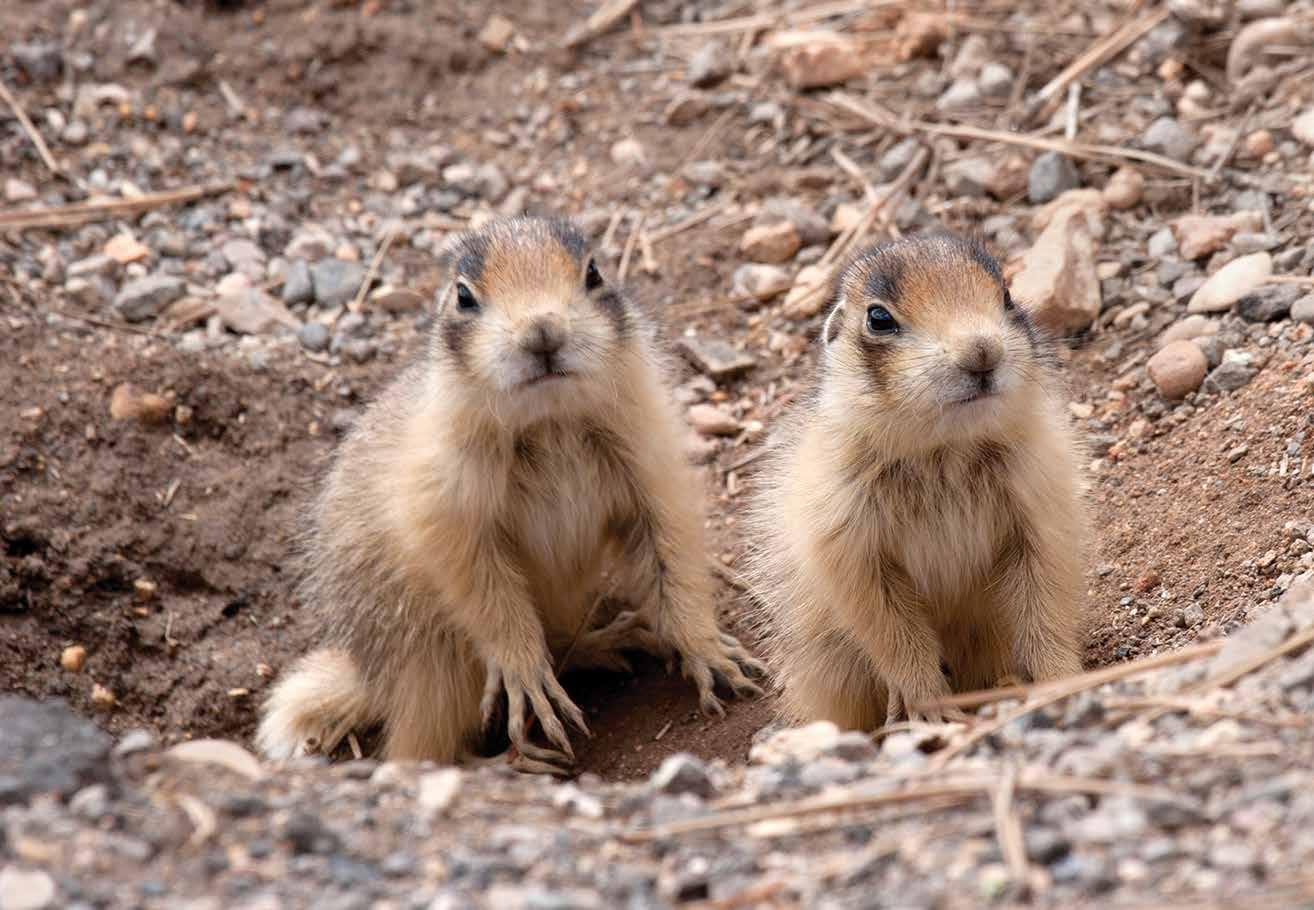
Two Utah prairie dogs on the first day they appear aboveground at weaning, when they are about 5.5 weeks old and weigh about 200 grams.
The Latest Outlandish Discovery
Individuals of different species commonly compete with each other. African lions and spotted hyenas compete for the same prey, for example. To reduce interspecific competition, natural selection commonly favors divergence in ecology, morphology, or physiology. But natural selection has favored a different, unusual strategy for one species of prairie dog that John has studied: Whitetailed prairie dogs kill, but do not consume, Wyoming ground squirrels encountered in the prairie dog’s home territory. Like prairie dogs but smaller, ground squirrels are colonial, diurnal, burrowing rodents that inhabit western North America and eat the same plants that prairie dogs also consume.
In collaboration with Charles Brown, John discovered that interspecific killing (IK) of ground squirrels by prairie dogs was common, involving a preposterous 47 different killers of both sexes. In 3 of 6 years, the number of IKs was higher that the number of ground squirrels killed by the combined efforts of fifteen mammalian and avian predators such as American badgers, coyotes, and Swainson’s hawks. In a typical IK, the prairie dog repeatedly bites the ground squirrel in the neck or thorax over a period of 1–3 minutes until death, and then walks away with no consumption. Most killers (N = 28) slew a single ground squirrel, but 19 serial killers slew two or more ground squirrels. One female killed six ground squirrels over 5 years, another female killed nine over 4 years, and a third female killed seven juveniles from the same litter in a single day. John’s large sample size (N = 163 IKs, over 6 years) allowed him to demonstrate that females that kill ground squirrels have significantly higher annual and lifetime reproductive success than nonkillers. These differences in Darwinian fitness probably result from lower interspecific competition with ground squirrels for vegetation following IKs – so that killers and their offspring consequently have more food.
Because IKs were so quick, subtle, and unanticipated, John and his students studied white-tailed prairie dogs for 4 years before they detected the first case. Their compelling results should help other ecologists to realise that IKs might be happening frequently but surreptitiously, and with significant consequences for Darwinian fitness, for animals they have been studying for many years.
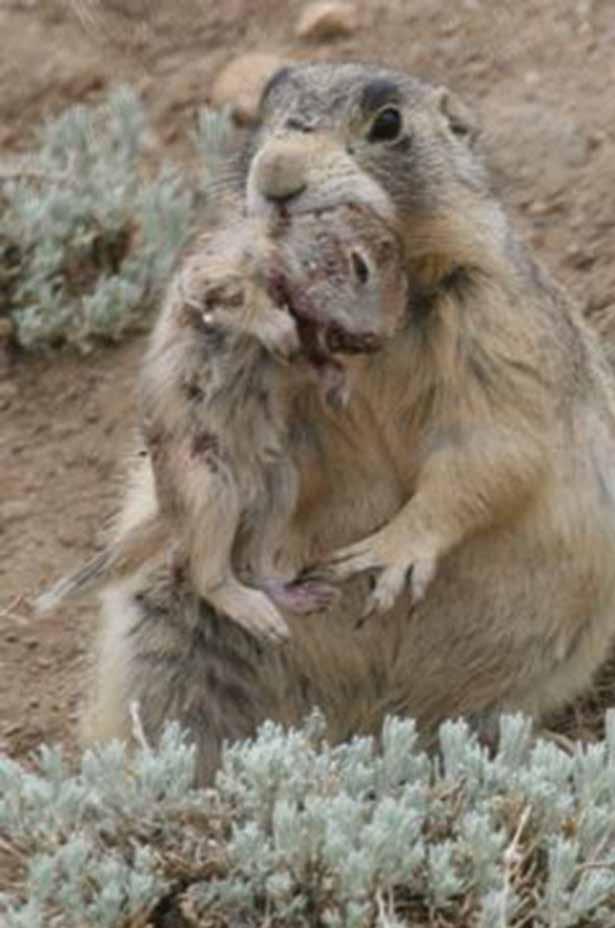
One-year-old female white-tailed prairie dog that has just killed a juvenile Wyoming ground squirrel via a series of bites to the neck. Photo by John Hoogland.
The Future of the Prairie Dog
Prairie dogs have faced many serious challenges over time, mostly from humans. Because prairie dogs are herbivores that commonly live in grasslands used for raising cattle, ranchers have worried that they will consume vegetation necessary to fatten their livestock. Such competition does sometimes occur, but cattle nevertheless often prefer to forage at colony-sites because the plants there can be more nutritious. Ranchers also fret that their cattle will incur broken legs from stepping into burrows, but such fractures are exceedingly rare. These overrated concerns have led ranchers to shoot and poison billions of prairie dogs over the last 150 years, often with assistance from federal and state agencies. In recent years, disease has been another problem for prairie dogs: Millions have died from epidemics of bubonic plague, an introduced disease to which prairie dogs have no good defence. Further, housing communities and shopping malls have destroyed much of their natural habitat. As a result, two species of prairie dogs are now on the list of threatened and endangered species, and the other species probably should be on that list as well.
John has documented that prairie dogs have a profound impact on their grassland ecosystems, and are therefore keystone species. For example, their burrows change the landscape and soil chemistry, affect the cycling of water and nutrients, alter floral species composition, and provide shelter and nesting habitat for many other organisms such as burrowing owls, tiger salamanders, and hundreds of species of insects and spiders. Further, prairie dogs serve as prey for numerous predators – American badgers, bobcats, and coyotes to name a few mammalian enemies, and golden eagles, northern goshawks, and prairie falcons to name a few avian enemies. Escaping extinction for at least one species, the blackfooted ferret, is dependent on the long-term survival of prairie dogs, because ferrets feed almost exclusively on prairie dogs. If prairie dogs disappear, grassland ecosystems as we know them will vanish as well.
John hopes that his research will help to conserve prairie dogs. One of his key findings is helping to dispel a century-old myth perpetuated by farmers and ranchers: that prairie dogs are fast-breeding like mice and rats, and will take over grasslands unless they are exterminated. By contrast, John’s tracking of thousands of prairie dogs first captured as juveniles demonstrates that prairie dogs do not live long (usually only 1 or 2 years), that many females do not reproduce every year, and that successful females can only wean a small number of offspring (usually three or four, with a maximum of eight) per year.
John has just begun to write his ‘magnum opus’ – a book in which he will attempt to summarise and explain all 44 years of his research with prairie dogs. He reflects, ‘If we want to save prairie dogs and their ecosystems, knowledge is power, and my research is providing information on every aspect of the biology of prairie dogs. Unfortunately, I will not live long enough to answer all the questions I still have. I especially want to better understand the serial killing of juveniles of close kin by female black-tailed prairie dogs, and the serial killing of Wyoming ground squirrels by white-tailed prairie dogs.’
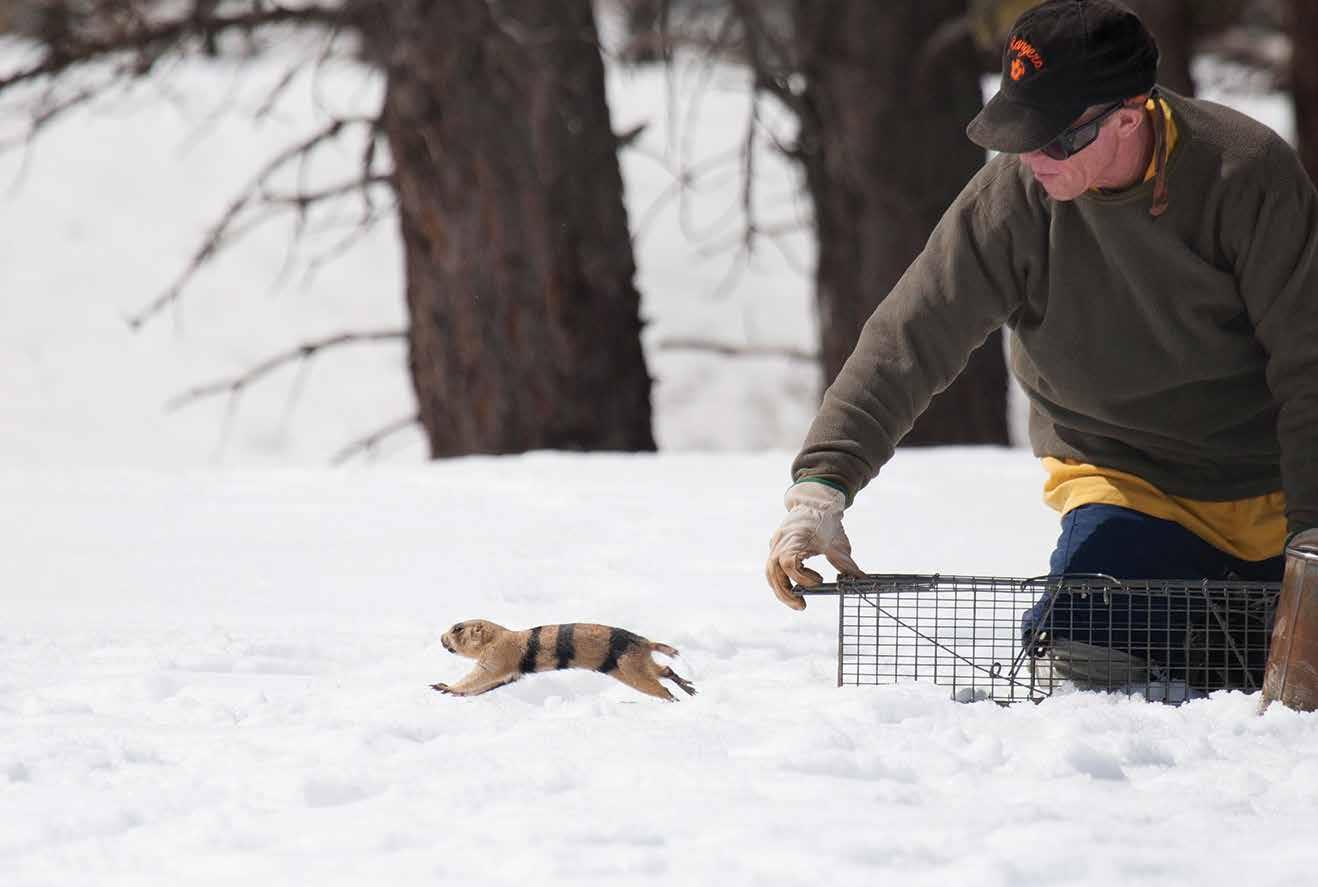
CREDIT: Elaine Miller Bond (www.elainemillerbond.com)
John Hoogland releasing a Utah prairie dog uniquely marked with three vertical stripes for identification from as far away as 100 m.
Meet the researcher

Professor John L. Hoogland
Professor of Wildlife Ecology
Appalachian Laboratory
The University of Maryland Center for Environmental Science
Frostburg, Maryland, USA
Professor John Hoogland completed his BSc (1971) and PhD (1977) at the University of Michigan. After completing a postdoc at the University of Minnesota in 1979 and serving as an Assistant Professor at Princeton University for several years, John joined the Appalachian Laboratory of the University of Maryland Center for Environmental Science in 1985, where he is currently a Professor of Wildlife Ecology. Since he first saw them when he was a graduate student in 1974, prairie dogs have fascinated John. Over the last 44 years, he has devoted his career to finding answers to questions about the conservation, ecology, and social behaviour of these amazing grassland rodents. As John frequently says: ‘Gotta love those prairie dogs.’
Awards during John’s career include the Peter Okkelberg Award for outstanding achievement in biology (1971), the American Society of Mammalogists Alma Shadle Award (1976), the Harry Frank Guggenheim Career Development Award (1986), and the Prairie Dog Protector of the Year Award (2015). Citations to John’s research number >5,000, and span >120 journals. His discoveries have been reported in hundreds of newspapers around the world, 10 textbooks, 9 radio programs, 11 television programs, and also >50 popular magazines such as Atlantic, Audubon, National Geographic, National Wildlife, New Scientist, Ranger Rick, Science News, and Smithsonian.
CONTACT
T: (+1) 301 689 7130
W: http://www.umces.edu/al/people/jhoogland
KEY COLLABORATORS
Professor Charles Brown, University of Tulsa
Professor David Eads, United States Geological Survey
FUNDING
Since he started studying prairie dogs in 1974, 22 different organisations have funded John’s research. Recent sources of funding include Colorado Parks and Wildlife, Denver Zoological Foundation, Nati
REFERENCES
JL Hoogland, CR Brown, Prairie dogs increase fitness by killing interspecific competitors, Proceedings of the Royal Society B, 2016, 283, 1–7.
JL Hoogland, Prairie dogs disperse when all close kin have disappeared, Science, 2013, 339, 1205–1207.
JL Hoogland, Why do female prairie dogs copulate with more than one male?—Insights from long-term research, Journal of Mammalogy, 2013, 94, 731–744.
JL Hoogland, editor, Conservation of the black-tailed prairie Dog, Island Press, Washington, District of Columbia, 2006.
JL Hoogland, The black-tailed prairie dog: Social life of a burrowing mammal, University of Chicago Press, 1995.
JL Hoogland, Levels of inbreeding among prairie dogs, American Naturalist, 1992, 139, 591–602.
JL Hoogland, Infanticide in prairie dogs: Lactating females kill offspring of close kin, Science, 1985, 230, 1037–1040.


